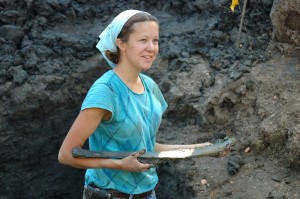Discoveries Continue At Mahaska Mammoth Site

LeAnn Van Donselaar is seen here just moments after releasing this mammoth rib from the ground where it had been buried for 14,000 years.
Oskaloosa, Iowa – The discoveries continue at a rural Mahaska County farm. Scientists continue to unearth not only more mammoth bones, but the understanding of prehistoric Iowa and its ecosystem.
The University of Iowa Museum of Natural History has been at the forefront of coordinating the summer long process.
Scientist now know that there are at least two mammoths buried at the site, with the recent discovery of a second right shoulder bone. This creates even more questions to now figure out the answers to.
Scientists have removed large pieces of spruce tree that are embedded with the mammoth bones, and currently estimate the age of the wood to be at least fourteen thousand years old. They hope to carbon date the bones with the wood samples to see how much shifting the bones might have done, although all of them agree, the bones haven’t traveled far because of the condition they are in. Carbon dating the different samples would help give them a better picture of why the site ended as it has, and what vegetation samples also date to the same time period as the mammoths.
Underneath that spruce tree stump was the skull of the mammoth. It’s been turned upside down with time, but the jaw was extracted from the site, which took four people to help get it out of the hole.
Art Bettis with the University of Iowa Department of Geo-science says that a piece of organic material, like a tree, survives the ages “because it remains wet.” Bettis says that the discoveries buried at the site have been preserved because they have been saturated with water. “When we get into these really saturated environments, the microbes that are there aren’t very efficient at decomposing organic matter.” Bettis says that it’s possible to last a million years in such an environment.
Bettis called the site, “The perfect storm of organic preservation.”
The discovery of the tooth from the mammoth will make it easier to identify what kind of mammoth at least one of them was. It will help in identifying the age of the mammoth and with the protection the enamel on the tooth provides, radio carbon dating will be easier. It will also be able to help identify the types of food the mammoth was eating.
Also recently found was a tusk from the mammoth. David Brenzel of the Indian Creek Nature Center says that the tusk grows rings like a tree. He explains that when you take a core sample from a tusk, the rings will be able to tell you, “it’s good years, it’s bad years. It’s healthy years and it’s stressful years.”
“The more information we get, the more answers we get. This is really an important scientific site here.” Brenzel explained about the site and it’s importance for the history of mammoths.
It’s still too early in the process to know how much information being found at the site will or could change what is known about mammoths and how they lived their lives. “There are some interesting hints.” Brenzel says. “We’re finding spruce needles, fur needles, lurch needles with an animal we’re not sure was living here at those times. We have to account for what it was doing here in this environment.”
LeAnn Van Donselaar has been volunteering her time at the dig site, and says that it’s been something that interests her, so that’s why she’s there. Van Donselaar has an Earth Science degree, “but I’ve never done any sort of paleontology, but I’m learning.”
Van Donselaar was enjoying a deeper spot in the small creek that is near the dig site. The deeper water made it easier to wash the mammoth rib bone she had just uncovered.
“When you have the opportunity [the land owner] has given us, really the whole community has given us.” Titan Machinery of Oskaloosa has been a major part of the community involvement with the donation of a back-hoe to the group of scientists and community members that have taken part in the dig. “Don’t believe for a second we could have dug this hole all by hand. It’s when you have a whole community like this,” says Brenzel.
He also used the example of LeAnn, who had just recently graduated from Northern Iowa, as part of the community coming together to help make the dig possible, along with someone donating a gas generator or a multitude of other essentials during the summer that have helped.
Scientists and students from all around the state are taking the opportunity to learn more and experience a dig such as this one. William Penn and its students have had the opportunity to participate as well. Some Penn students will be having even more hands-on at the site in September.
Brenzel says that the dig, “Has such an interesting story to tell.”
Brenzel explained that what makes this dig so interesting isn’t necessarily the number of bones, but “is the fact that we know they were living right here. These animals were living right here.”
Another aspect of the dig that has changed recently is the amount of water gathering in the excavated hole. Recent rains have made the need for pumping water out of the hole something they didn’t have to do all summer long during the height of the drought, but no one’s complaining.










